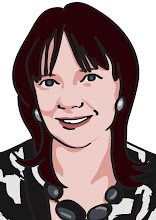This post offers you a short 'workshop' in Dwi Pada Pittam - you will get the most benefit by also watching the accompanying video.
The risks involved in this posture is jamming of the lower back. The low back, lumbar region, is more mobile than other parts of the spine - it has shorter spinous processes, no ribs attached to restrict movement and also our Western sedentary lifestyles lead to general kyphosis (rounding of the upper back) which weakens the upper back muscles anyway. So if we don't practice this posture mindfully, our body takes the path of least resistance and we can end up jamming and hurting our low back.
So to practice Dwi Pada Pittam to avoid this and to open the heart, strengthen the back and avoid spinal jamming:
- Relax - start lying on the floor with the knees bent and feet pulled in towards the buttokcs and firmly planted on the floor. Inhale and sweep the arms up. Exhale and tip your legs to the right, feel the left shoulder blade shrugging into the floor. Then inhale up and exhale legs to the left, feel the right shoulder release to the floor. Feel the back of the neck and shoulders flat on the floor, pulled down by your back into the floor. Feel the thoracic (upper) spine releasing down into the floor.
- Initiate the movement - exhale and tilt the pelvis back, pushing the low back into the floor. Inhale and take the pelvis into the air, breath by breath. As you inhale and lift imagine an exercise ball being slowly filled with air beneath you, lifting your spine up softly from underneath you. As you lift, feel the curve flowing along the length of the spine in a rounded smooth curve, along your entire spine.
- Keep your chin tucked down, your neck long and shoulders grounded into the floor. Bring the apex of the curve into your UPPER back , behind your heart, so that your pelvis moves upward and toward the ceiling and your chest expands towards your face.
- Stretch your coccyx towards your knees and pull your abdominals down towards your spine. Open your front thighs and groin towards the ceiling and be very grounded in your feet and knees. Knees are parallel and feet and knees hip width apart.
- When your chest is fully expanded, raise your pelvis as high as you can - feeling that imaginary ball beneath you expanded to its fullest raising you up. Stay where you are and hold this maximum position as effortlessly as possible. Remember 'sthira sukhanam asanam' - steadiness and comfort in the posture.
- Uncurl slowly on the exhale, release your abdominals down and release the pelvis back down uncurling the spine to the floor vertebra by vertebra, as if you are easing into soft foam, feel the vertebrae release one by one from the thoracic to the sacrum.
- Lift up again as before - then when fully extended lift your arms up and sweep them down towards your feet, interlacing your hands beneath your hips and straighten them away from your shoulders.
- Roll your upper arms out, move your shoulders away from your ears, squeeze your shoulder blades together and down. move your upper arms inwards and press your shoulders into the floor - ease and squeeze into this so that you are resting directly on your shoulders. Breathe smoothly and evenly.
- To release out, release the hands sweeping them overhead again and release and uncurl the spine slowly the floor.











No comments:
Post a Comment